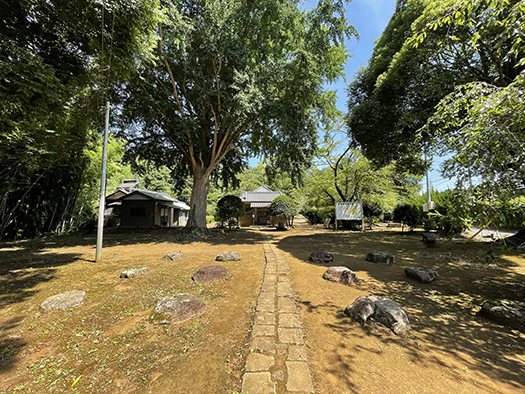



古代の関東平野の状況を実体験する旅、いわゆる「東国三社」という鹿島・香取・息栖の3つの神社探訪ではありますが、実はもうひとつ深く興味を刺激されていた「龍角寺」。現在は廃寺跡が残っている。
画像は、古代での寺のありようを伝える現地説明板でみた復元絵画・配置図とそれに対照した正面外観写真。写真の手前側には礎石だけになった仁王門跡もある。
こちらは成田空港にほど近い「栄町」にあって、古代関東の地形を感じさせる印旛沼のような水郷的雰囲気も残っている。こうした立地環境にあり、交通も困難な地域と認識される地域でありながら、この龍角寺はその創建をおおむね600年代中期頃まで遡ることが知られている。
「当地には古代から仏教寺院が存在したことは間違いない。発掘調査によって、南大門から入り、中門を抜け、左手に金堂、右手に塔、そしてその奥に講堂が配されるという、いわゆる「法起寺式伽藍配置」の遺構が検出され、創建瓦は周縁に三重園文のある単弁八葉蓮華文の山田寺式の系譜を持つ軒丸瓦である。関東でもいくつかの寺院跡で山田寺式の軒丸瓦が出土しているが、その中でも最も古い様式。」
「寺の南には最後の前方後円墳といわれる浅間山古墳や、畿内の大王陵を凌駕する終末期最大の方墳龍角寺岩屋古墳などがあり、馬来田の上総大寺廃寺(千葉県木更津市)、武社の真行寺廃寺(同山武市)、上毛野の山王廃寺(群馬県前橋市)などとともに、国造制から律令制への移行段階に建立された印波国造の領域の初期寺院とされ、畿内以外では最古にあたる寺院。龍角寺岩屋古墳は典型的畿内型終末期古墳であり、畿内中枢との密接的な関係なしに理解できないという。」
「方墳は用明天皇陵の春日向山古墳や、推古天皇陵である山田高塚古墳をはじめ、蘇我馬子の墓の可能性の高い石舞台古墳といったように、蘇我氏関係の墳墓に採用されている。さらに規模においてそれらを凌駕しており、当時の最大権力・蘇我氏が造営に深く係っていたと推測される。龍角寺の創建「瓦」も一族の蘇我倉山田石川麻呂によって創建された山田寺式の瓦を採用していることから、龍角寺造立者は龍角寺岩屋古墳の被葬者の系譜下にあり、蘇我氏系の氏族であったとする見解もある。」〜以上、Wikipediaより。
引用が長くなってしまったけれど、この廃寺跡を彷徨っていると各所で気の遠くなる説明記述板がボーッとした脳味噌に怒濤のように降り注いでくる(笑)。
とても一度の訪問では咀嚼しきれないほどの興味津々な歴史のナゾが襲ってくるのであります。
わたしは密かに伊能忠敬さんを尊崇しているのですが、かれは健康人生を心がけて、人生の晩年期にこそ日本人のための活動を行った。はるかな落第生的な凡百として、せめてこういった昔人の痕跡と向き合っていきたいと考えています。
この廃寺跡から、そういった空気感が立ち上ってきて無性に揺さぶられた次第です。
English version⬇
Traces of the Ancient Soga Clan, Ryukakuji Temple (1): Exploration of Three Shrines in the East – 8
This is a region in Kanto that can be traced back to the time of the Kunizukuri. The most advanced temple architecture in the Kinai region at that time was transplanted to the Kanto region. The influence of the Soga clan is strong in its construction. The Soga clan’s influence is strong in the construction of this temple.
Although this is a trip to actually experience the conditions of the Kanto Plain in ancient times, the so-called “Three Shrines of the East,” an exploration of the three shrines of Kashima, Katori, and Sosu, there was actually one more deeply stimulating interest: the Ryukakuji Temple. Today, the ruins of the abandoned temple remain.
The image shows a front exterior view contrasted with a restored painting and layout seen on a local explanatory board that tells how the temple was in ancient times. In the foreground of the photo are the ruins of the Niomon Gate, which is now only a foundation stone.
This temple is located in Sakae-machi, near Narita Airport, in an area that still retains the atmosphere of a water village like Obanuma, which reminds us of the topography of the ancient Kanto region. Despite its location in such an environment, and despite the fact that the area is considered difficult to access, Ryukakuji Temple is known to have been founded in the mid-600s.
There is no doubt that a Buddhist temple has existed in the area since ancient times. Excavations have revealed the remains of a so-called “Hokki-ji style” temple layout, with the main hall on the left, the pagoda on the right, and the lecture hall in the back, entered through the main south gate, and with eaves round tiles in the Yamada-dera style with a single-petaled eight-leaf lotus flower design with a threefold garden pattern on the periphery. This is the oldest of the Yamadadera style eaves round tiles that have been excavated from several temple sites in the Kanto region.
To the south of the temple are the Asamayama Kofun Tumulus, said to be the last forward-rear round burial mound, and the Ryukakuji Iwaya Kofun Tumulus, the largest square burial mound of the Terminal Period, surpassing the great imperial tombs in the Kinai region. It is the oldest temple outside the Kinai region. The Ryukakuji Iwaya burial mound is a typical Kinai-type Terminal Period burial mound, and cannot be understood without its close relationship to the Kinai center.
The square burial mounds are used for tombs related to the Soga clan, such as the Kasuga Mukoyama burial mound for Emperor Yomei, the Yamada Takatsuka burial mound for Emperor Suiko, and the Ishibutai burial mound, which is likely to be the tomb of Soga Umako. The tombs are even larger in scale than those of the other tombs, suggesting that the Soga clan, the most powerful clan at that time, was deeply involved in their construction. The “roof tiles” used in the construction of Ryuzumakuji Temple are also in the Yamadadera style, which was created by the family of Soga Kurayamada Ishikawamaro, which leads some to believe that the builders of Ryuzumakuji Temple were of the Soga lineage and descended from the family of the buried in the Ryuzumakuji Iwaya tumulus. 〜The above is from Wikipedia.
The above is from Wikipedia. I have been quoted for a long time, but as I wandered around the ruins of this abandoned temple, I was bombarded with dizzying explanations and description boards at various places like a raging wave in my foggy brain (laugh).
(Laughs). I was bombarded with so many interesting historical riddles that I could not digest them all in a single visit.
I secretly revere Mr. Tadataka Ino, who tried to lead a healthy life and did activities for the Japanese people only in the later years of his life. As an ordinary person who is far from being a dropout, I would like to at least face the traces of these ancient people.
I was moved by the atmosphere that rose up from the ruins of this abandoned temple.
Posted on 8月 12th, 2023 by 三木 奎吾
Filed under: 日本社会・文化研究, 歴史探訪







コメントを投稿
「※誹謗中傷や、悪意のある書き込み、営利目的などのコメントを防ぐために、投稿された全てのコメントは一時的に保留されますのでご了承ください。」
You must be logged in to post a comment.